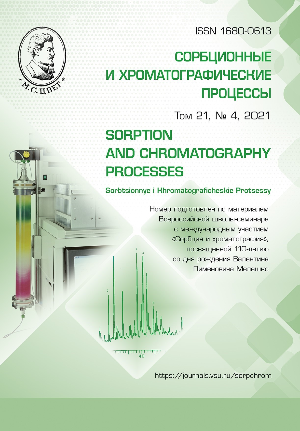In silico study of structural features of lipases from various producers as potential agents for immobilisation on charged and hydrophobic carriers
Abstract
Lipase is a hydrolytic enzyme derived from many organisms such as animals, plants, fungi, and bacteria. It splits triglycerides to monoglycerides and fatty acids. Additionally, it has a broad substrate specificity.
Lipases are used in the food industry and other areas of human activity. A characteristic feature of many lipases is the phenomenon of surface activation, which determines their characteristic dependence of the rate of the catalytic reaction on the concentration and the matter state of the substrate.
It has been proven that the functioning of enzymes depends on their structural features. Interior cavities, tunnels, and pores are integral components of the native protein conformation. They play an important role in the transport of the substrate, cofactors, and ions to the active and allosteric sites of the enzyme. In addition, their configuration can affect the thermal stability of enzymes. Therefore, the study of the above-mentioned structures is necessary to understand the mechanisms of biocatalysts’ functioning. Also, an important element of the enzyme structure is the accumulation of charged and hydrophobic amino acid residues on their surface. This property must be taken into account when planning routes for the adsorption immobilisation of biocatalysts on various carriers to be used in industry and medicine.
The work investigated the composition, localisation, and configuration of interior cavities, tunnels, pores, and surface accumulations of charged and hydrophobic amino acid residues in lipase molecules from Rhizopus niveus (PDB ID: 1LGY), Rhizomucor miehei (PDB ID: 3TGL), Burkholderia cepacia (PDB ID: 1OIL), pancreatic lipases Homo sapiens (PDB ID: 1N8S) and Equus caballus (PDB ID: 1HPL). The MOLE and Maestro software were used to calculate the parameters and to visualise the structures. It was shown that there are 2, 1, 5, 5, and 2 tunnels, respectively, and no pores for these enzymes; as well as there were 6 interior cavities for lipases from R. niveus and E. caballus, 5 interior cavities for a molecule from R. miehei and
2 interior cavities for enzymes from B. cepacia and H. sapiens. The amino acid composition and profiles of the tunnels of the studied lipases were presented. It was revealed that these structures were not connected with each other via common voids. It was established that hydrophobic amino acid residues dominate in most of the tunnels of these enzymes. The structure, localisation, and composition of accumulations of charged and hydrophobic amino acid residues on the surfaces of macromolecules were studied. It was revealed that the location of these accumulations might influence the binding of lipases with the carrier during their adsorption immobilisation.
Downloads
References
Adlercreutz P., Chemical Society Re-views, 2013, Vol. 42(15), pp. 6406-6436.
Raveendran S., Parameswaran B., Beevi Ummalyma S., Abraham A. et al., Food Technol Biotechnol., 2018, Vol. 56(1), pp. 16-30.
Iso M., Chen B., Eguchi M., Kudo T. et al., Journal of Molecular Catalysis B: Enzymatic, 2001, Vol. 16(1), pp. 53-58.
Quayson E., Amoah J., Hama S., Kondo A. et al., Renewable and Sustainable Energy Reviews, 2020, Vol. 134, p. 110355.
Zeng H., Liao K., Deng X., Jiang H. et al., Process Biochemistry, 2009, Vol. 44(8), pp. 791-798.
Gurung N., Ray S., Bose S., Rai V., BioMed research international, 2013. Available at: https://www.hindawi.com/journals/bmri/2013/329121/.
Sharma S., Kanwar S.S., The Scientific World Journal, 2014. Available at: https://www.hindawi.com/journals/tswj/2014/625258/.
Hjorth A., Carrière F., Cudrey C., Wöldike H. et al., Biochemistry, 1993, Vol. 32(18), pp. 4702-4707.
van Tilbeurgh H., Egloff M.P., Mar-tinez C., Rugani N. et al., Nature, 1993, Vol. 362(6423), pp. 814-820.
Zorica D., Knezevic S.S., Siler-Marinkovic, Ljiljana V., APTEFF, 2004, pp. 151-164.
Coleman R.G., Sharp K.A., Journal of chemical information and modeling, 2010, Vol. 50(4), pp. 589-603.
Kokkonen P., Bednar D., Pinto G., Prokop Z. et al., J. Biotechnology advances, 2019, Vol. 37(6), p. 107386.
Woycechowsky K.J., Seebeck F.P., Hilvert D., Protein science, 2006, Vol. 15(5), pp. 1106-1114.
Shelamova S.A., Selemenev V.F., Krylov I.A., Yanysheva N.V. et al., Biotekhnologiya, 2007, No 3, pp. 52-57.
Holyavka M.G., Artyuhov V.G. Inulinazy v usloviyah razlichnogo mikrookruzheniya: biofizicheskie, kineticheskie i strukturno-funkcional'nye svojstva, Voro-nezh, Izdatel'skij dom VGU, 2018, 288 p.
Holyavka M.G., Artyuhov V.G. Immobilizovannye biologicheskie sistemy: biofizicheskie aspekty i prakticheskoe primenenie (uchebnoe posobie). Izdatel'skij dom VGU, 2017, 261 p.
Jesionowski T., Zdarta J., Krajewska B., Adsorption, 2014, Vol. 20(5-6), pp. 801-821.
Klibanov A.M., Nature, 200, Vol. 409(6817), pp. 241.
Bourne Y., Martinez C., Kerfelec B., Lombardo D. et al., Journal of molecular biology,1994, Vol. 238(5), pp. 709-732. Available at: https://www.ncbi.nlm.nih.gov/Structure/pdb/1HPL
Brzozowski A.M., Derewenda Z.S., Dodson E.J., Dodson G.G. et al. Acta Crys-tallographica Section B: Structural Science, 1992, Vol. 48(3), pp. 307-319. Режим до-ступа: https://www.ncbi.nlm.nih.gov/Structure/pdb/3TGL
Kim K.K., Song H.K., Shin D.H., Hwang K.Y. et al. Structure, 1997, Vol. 5(12), pp. 1571-1584. Available at: https://www.ncbi.nlm.nih.gov/Structure/pdb/1OIL
Kohno M., Funatsu J., Mikami B., Ku-gimiya W. et al., The Journal of Biochemis-try, 1996, Vol. 120(3), pp. 505-510. Available at: https://www.ncbi.nlm.nih.gov/Structure/pdb/1LGY
van Tilbeurgh H., Sarda L., Verger R., Cambillau C., Nature, 1992, Vol. 359(6391), pp. 159-162. Available at: https://www.ncbi.nlm.nih.gov/Structure/pdb/1N8S
Selemenev V.F., Rudakov O.B., Eliseeva T.V., Voronyuk I.V. et al., Vestnik VGU. Seriya: Himiya. Biologiya. Farmaciya, 2021, No 1, pp. 20-35.
Moris P. Poverhnost' i mezhfaznye granicy v okruzhayushchej srede. Ot nanourovnya k global'nomu masshtabu. M., Binom. Laboratoriya znanij, 2015, 540 p.







